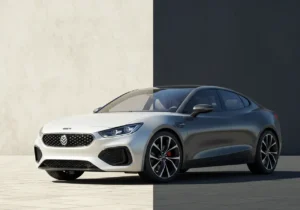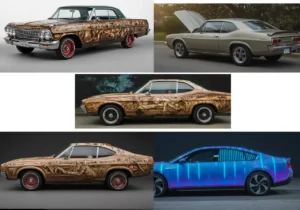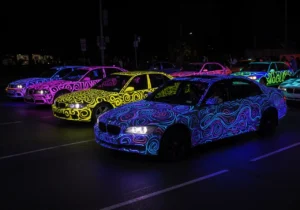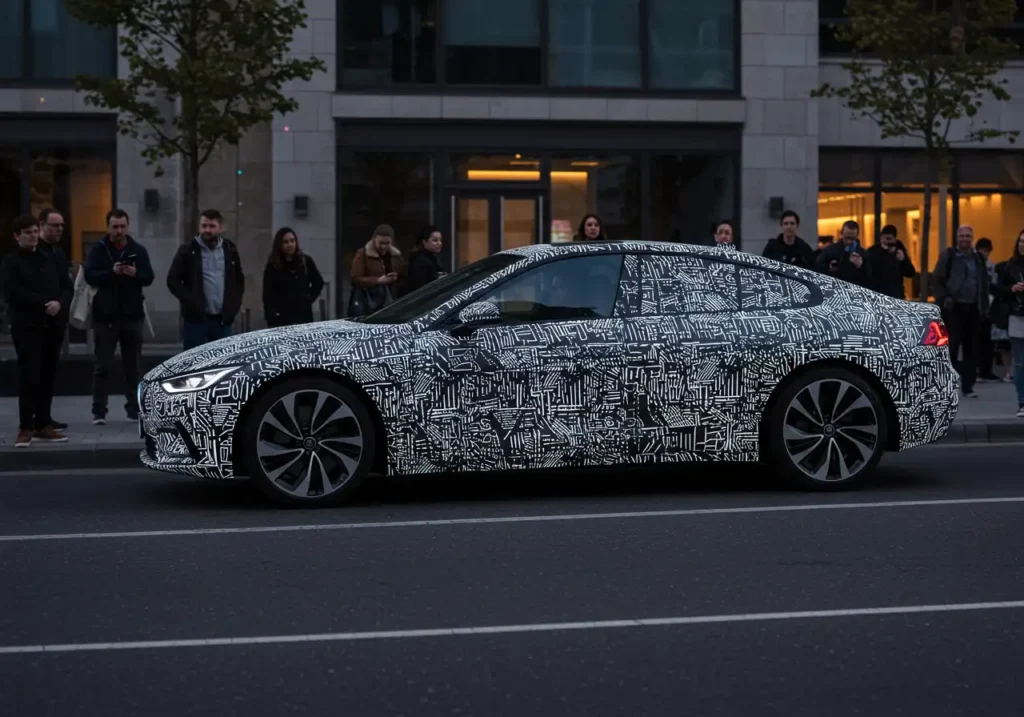Introduction: A New Era of Automotive Art
From Murals to Digital Wraps: A Brief History of Cars as Art
To understand the importance of E-Ink car wraps, it’s helpful to look back at how cars have functioned as art in the past century:
- 1940s–1960s: Custom paint jobs and airbrush murals became popular, especially in hot rod and lowrider communities.
- 1970s–1990s: Vinyl wraps emerged as a cheaper, faster alternative to hand-painting, allowing for detailed graphics and branding.
- 2000s–2010s: High-resolution digital printing transformed wraps into true photographic canvases.
- 2020s: E-Ink wraps now enable cars to transform dynamically, changing the role of vehicles from static art to interactive installations.
This progression shows a steady march toward more flexible, accessible, and innovative approaches to vehicle aesthetics.
What Exactly Are E-Ink Car Wraps?

E-Ink is a display technology that uses millions of tiny microcapsules filled with charged black and white pigments. When an electric current passes through, the pigments rearrange, changing the surface color. Unlike LED screens, E-Ink consumes very little power and is highly visible in sunlight — perfect for automotive use.In practical terms, imagine your car shifting from sleek matte black during a formal event to bright white in summer heat, or showcasing geometric patterns for a car show. That’s the promise of E-Ink car wraps.The best-known prototype so far is BMW’s iX Flow, which demonstrated E-Ink technology at CES. This vehicle could alternate between black and white, or display stripes and waves across its body panels. Although still experimental, it captured global attention and hinted at the future of adaptive automotive art.Learn more directly from BMW’s official showcase of E-Ink innovation.
The Technology Behind Adaptive Surfaces
Adaptive wraps combine E-Ink sheets with automotive-grade protective coatings. Beneath the protective layer, thin panels cover the car’s body and connect to a central control unit. Drivers may use an app or onboard controls to adjust the surface’s appearance instantly.
Key Features:
- Low Power Consumption: E-Ink only uses power when changing states, making it energy-efficient.
- High Contrast: Unlike glossy paint, E-Ink displays are readable in bright sunlight.
- Programmability: Drivers can store multiple themes, cycling between them depending on mood or setting.
- Durability: Protective coatings resist scratches, UV damage, and weather.
While current E-Ink wraps are limited mostly to grayscale, researchers are developing color E-Ink solutions that could expand the spectrum dramatically.
Creative Possibilities for Artists and Enthusiasts

The artistic potential of E-Ink wraps is enormous. Imagine artists selling downloadable “wrap packs” the way musicians sell albums. A car could serve as a living gallery, rotating through different visual identities throughout the week. For example:
- Parades & Festivals: Cars can change designs throughout an event, turning every vehicle into a performance piece.
- Collectors: Owners can store dozens of unique art wraps, effectively owning a portfolio of automotive art in one car.
- Community Collaboration: Artists worldwide can design digital skins for cars in other countries, turning E-Ink into a global creative exchange.
This democratizes automotive art, making it easier for independent artists to gain visibility and monetize their work.
Sustainability Benefits of E-Ink Wraps
One of the most compelling aspects of E-Ink car wraps is sustainability. Traditional automotive painting involves solvents and chemicals that can harm the environment. Vinyl wraps, while less toxic, still generate waste with every replacement. Adaptive surfaces offer a cleaner alternative by reducing the need for constant re-painting.
Other green benefits include:
- Energy Efficiency: Lighter color modes reflect sunlight, reducing heat buildup and lowering air conditioning usage.
- Reduced Waste: Instead of discarding old wraps, drivers simply download new designs.
- Longevity: A single adaptive wrap could last for years, unlike vinyl that peels or fades.
In an era where consumers and regulators are prioritizing eco-friendly innovation, E-Ink wraps align perfectly with broader sustainability goals.
Challenges Facing E-Ink Car Wraps
Despite their promise, several barriers stand in the way of mass adoption:
- Durability: E-Ink panels must withstand road debris, harsh weather, and car washes without degrading.
- Color Range: Current wraps are limited in color; full-spectrum E-Ink is still under research.
- Cost: The technology is currently expensive, meaning early adoption is limited to high-end vehicles.
- Regulation: Governments may restrict moving graphics or bright flashes that could distract other drivers.
Overcoming these hurdles will be key to making adaptive wraps mainstream.
Marketing and Commercial Uses
For businesses, adaptive wraps offer new possibilities in branding and advertising. Ride-share companies, delivery services, and event organizers could all benefit from dynamic, reprogrammable graphics.
Imagine a fleet of delivery vans that automatically update their exterior ads based on location, time of day, or campaign schedule. Event sponsors could instantly transform entire car fleets into coordinated, animated displays that rival billboards in impact.
For this reason, marketing strategists are keeping a close eye on adaptive surface technology, anticipating its disruptive potential in the advertising industry.
 Case Study: BMW’s E-Ink Innovations
Case Study: BMW’s E-Ink Innovations
BMW has been a pioneer in integrating E-Ink into vehicles. Their iX Flow concept allowed drivers to switch between black and white panels. In 2023, they expanded with a color prototype using 32 color segments.
This experimentation is more than a publicity stunt. By investing heavily in research and development, BMW has positioned itself as a leader in merging art, tech, and sustainability. Their innovation may pave the way for other brands to follow, ultimately making E-Ink wraps more accessible to the public.
Beyond Cars: The Wider Impact of Adaptive Surfaces
While much of the focus is on cars, E-Ink adaptive surfaces have applications beyond the automotive world. Potential uses include:
- Motorcycles & Bicycles: Customizable surfaces for personalization and safety visibility.
- Public Transit: Buses and trains with dynamic route information or rotating cultural artwork.
- Architecture: Building exteriors that change color depending on weather or daylight.
- Fashion: Clothing and accessories with adaptive E-Ink panels for personal expression.
By 2035, adaptive surface design could permeate everyday life, creating a society where art and functionality merge seamlessly.
Legal and Cultural Considerations
As with any disruptive technology, cultural and legal questions will arise. Should there be restrictions on certain patterns that may distract drivers? Can police enforce traffic laws if cars change colors frequently? How will insurance companies handle claims involving adaptive surfaces?
On the cultural side, some purists may resist adaptive art, arguing that true automotive artistry lies in permanence and craftsmanship. Others will celebrate it as the democratization of creativity, giving everyone access to a constantly evolving palette.
The Road Ahead
Looking forward, we can expect E-Ink wraps to evolve rapidly. Within the next decade:
- Costs will decrease, making adaptive wraps available for mainstream vehicles.
- Full-color E-Ink technology will unlock vibrant, lifelike car designs.
- Integration with AI will allow vehicles to auto-adjust their skins based on mood, location, or weather.
- Automotive art festivals may evolve into interactive showcases with cars that change design every minute.
Ultimately, E-Ink car wraps are not just a trend; they represent a paradigm shift in how we view transportation, art, and technology.
Conclusion
Cars have always been cultural icons, symbols of identity, and platforms for creative expression. With E-Ink car wraps, that expression is no longer static — it’s alive, adaptive, and endlessly customizable. From eco-friendly benefits to new business models for artists, adaptive surface design is redefining the future of moveable art.
For a deeper dive into the technology powering this innovation, visit E Ink Corporation, the official source for E-Ink research and development.

